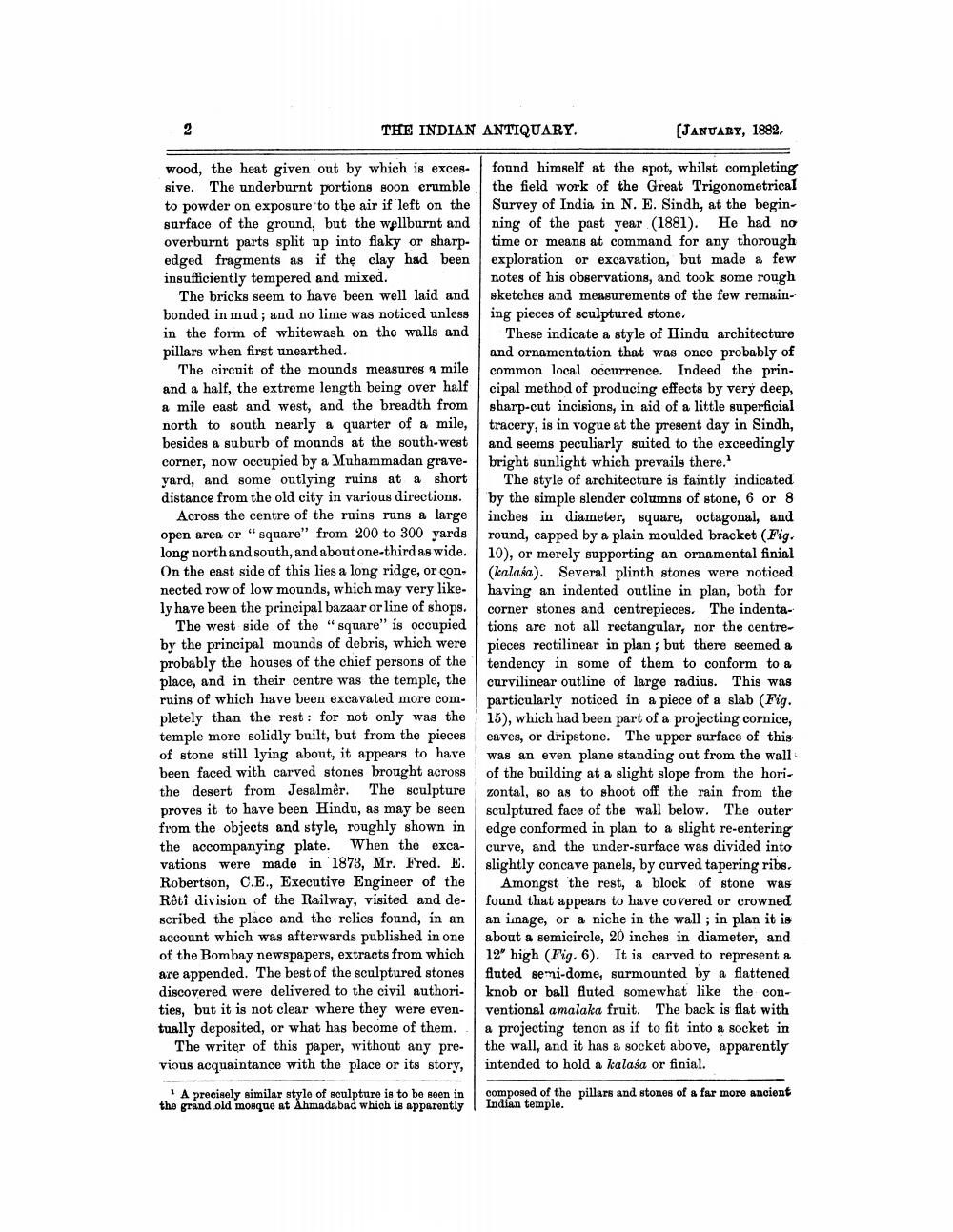Book Title: Indian Antiquary Vol 11 Author(s): Jas Burgess Publisher: Swati Publications View full book textPage 8
________________ THE INDIAN ANTIQUARY. (JANUARY, 1882 wood, the heat given out by which is excessive. The underburnt portions soon crumble to powder on exposure to the air if left on the surface of the ground, but the wellburnt and overburnt parts split up into flaky or sharpedged fragments as if the clay had been insufficiently tempered and mixed. The bricks seem to have been well laid and bonded in mud; and no lime was noticed unless in the form of whitewash on the walls and pillars when first unearthed. The circuit of the mounds measures 4 mile and a half, the extreme length being over half a mile east and west, and the breadth from north to south nearly a quarter of a mile, besides a suburb of mounds at the south-west corner, now occupied by a Muhammadan graveyard, and some outlying ruins at a short distance from the old city in various directions. Across the centre of the ruins runs a large open area or "square" from 200 to 300 yards long north and south, and about one-third as wide. On the east side of this lies a long ridge, or con. nected row of low mounds, which may very like ly have been the principal bazaar or line of shops. The west side of the "square" is occupied by the principal mounds of debris, which were probably the houses of the chief persons of the place, and in their centre was the temple, the ruins of which have been excavated more completely than the rest : for not only was the temple more solidly built, but from the pieces of stone still lying about, it appears to have been faced with carved stones brought across the desert from Jesalmer. The sculpture proves it to have been Hindu, as may be seen from the objects and style, roughly shown in the accompanying plate. When the excavations were made in 1873, Mr. Fred. E. Robertson, C.E., Executive Engineer of the Rôti division of the Railway, visited and described the place and the relics found, in an account which was afterwards published in one of the Bombay newspapers, extracts from which are appended. The best of the sculptured stones discovered were delivered to the civil authori. ties, but it is not clear where they were even- tually deposited, or what has become of them. - The writer of this paper, without any previous acquaintance with the place or its story, found himself at the spot, whilst completing the field work of the Great Trigonometrical Survey of India in N. E. Sindh, at the beginning of the past year (1881). He had no time or means at command for any thorough exploration or excavation, but made a few notes of his observations, and took some rough sketches and measurements of the few remaining pieces of sculptured stone. These indicate a style of Hindu architecture and ornamentation that was once probably of common local occurrence. Indeed the principal method of producing effects by very deep, sharp-cut incisions, in aid of a little superficial tracery, is in vogue at the present day in Sindh, and seems peculiarly suited to the exceedingly bright sunlight which prevails there. The style of architecture is faintly indicated by the simple slender columns of stone, 6 or 8 inches in diameter, square, octagonal, and round, capped by a plain moulded bracket (Fia. 10), or merely supporting an ornamental finial (kalasa). Several plinth stones were noticed having an indented outline in plan, both for corner stones and centrepieces. The indentations are not all rectangular, nor the centre pieces rectilinear in plan; but there seemed a tendency in some of them to conform to a curvilinear outline of large radius. This was particularly noticed in a piece of a slab (Fig. 15), which had been part of a projecting cornice, eaves, or dripstone. The upper surface of this was an even plane standing out from the wall of the building at a slight slope from the hori. zontal, so as to shoot off the rain from the sculptured face of the wall below. The outer edge conformed in plan to a slight re-entering curve, and the under-surface was divided into slightly concave panels, by curved tapering ribs. Amongst the rest, a block of stone was found that appears to have covered or crowned an image, or a niche in the wall ; in plan it is about a semicircle, 20 inches in diameter, and 12 high (Fig. 6). It is carved to represent a fluted semni-dome, surmounted by a flattened knob or ball fluted somewhat like the conventional amalaka fruit. The back is flat with a projecting tenon as if to fit into a socket in the wall, and it has a socket above, apparently intended to hold a kalasa or finial. composed of the pillars and stones of a far more ancient Indian temple. the grand old mosque at Ahmadabad which is apparentlyPage Navigation
1 ... 6 7 8 9 10 11 12 13 14 15 16 17 18 19 20 21 22 23 24 25 26 27 28 29 30 31 32 33 34 35 36 37 38 39 40 41 42 43 44 45 46 47 48 49 50 51 52 53 54 55 56 57 58 59 60 61 62 63 64 65 66 67 68 69 70 71 72 73 74 75 76 77 78 79 80 81 82 ... 396
